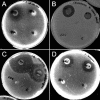Screening for bacillus isolates in the broiler gastrointestinal tract
- PMID: 15691955
- PMCID: PMC546680
- DOI: 10.1128/AEM.71.2.968-978.2005
Screening for bacillus isolates in the broiler gastrointestinal tract
Abstract
Spores from a number of different Bacillus species are currently being used as human and animal probiotics, although their mechanisms of action remain poorly understood. Here we describe the isolation of 237 presumptive gut-associated Bacillus spp. isolates that were obtained by heat and ethanol treatment of fecal material from organically reared broilers followed by aerobic plating. Thirty-one representative isolates were characterized according to their morphological, physiological, and biochemical properties as well as partial 16S rRNA gene sequences and screening for the presence of plasmid DNA. The Bacillus species identified included B. subtilis, B. pumilus, B. licheniformis, B. clausii, B. megaterium, B. firmus, and species of the B. cereus group, whereas a number of our isolates could not be classified. Intrinsic properties of potential importance for survival in the gut that could be advantageous for spore-forming probiotics were further investigated for seven isolates belonging to five different species. All isolates sporulated efficiently in the laboratory, and the resulting spores were tolerant to simulated gastrointestinal tract conditions. They also exhibited antimicrobial activity against a broad spectrum of bacteria, including food spoilage and pathogenic organisms such as Bacillus spp., Clostridium perfringens, Staphylococcus aureus, and Listeria monocytogenes. Importantly, the isolates were susceptible to most of the antibiotics tested, arguing that they would not act as donors for resistance determinants if introduced in the form of probiotic preparations. Together, our results suggest that some of the sporeformers isolated in this study have the potential to persist in or transiently associate with the complex gut ecosystem.
Figures




References
-
- Abu-Ruwaida, A. S., M. Husseini, and I. M. Banat. 1995. Salmonella exclusion in broiler chicks by the competitive action of adult gut microflora. Microbios 83:59-69. - PubMed
-
- Barbosa, T. M., and S. B. Levy. 2000. The impact of antibiotic use on resistance development and persistence. Drug. Resist. Updates 3:303-311. - PubMed
Publication types
MeSH terms
Substances
LinkOut - more resources
Full Text Sources
Other Literature Sources
Molecular Biology Databases
Miscellaneous

